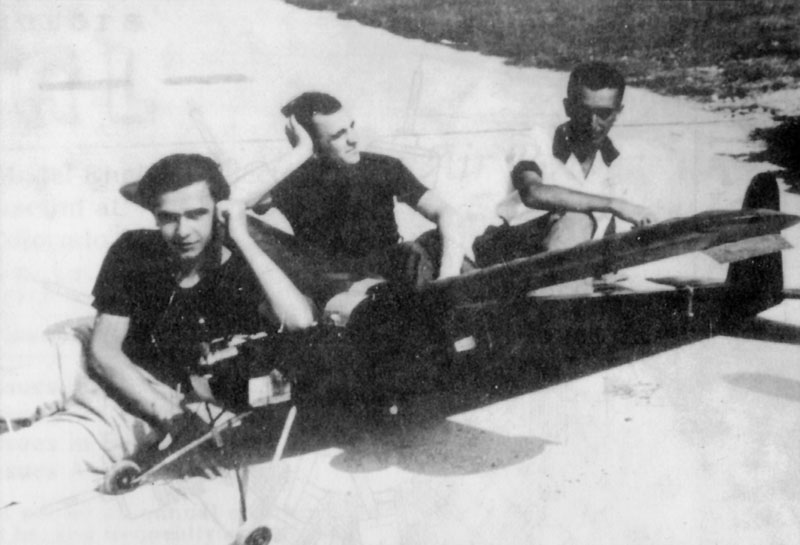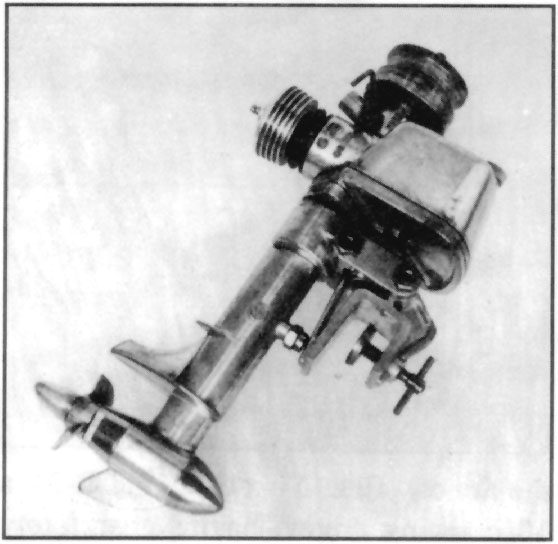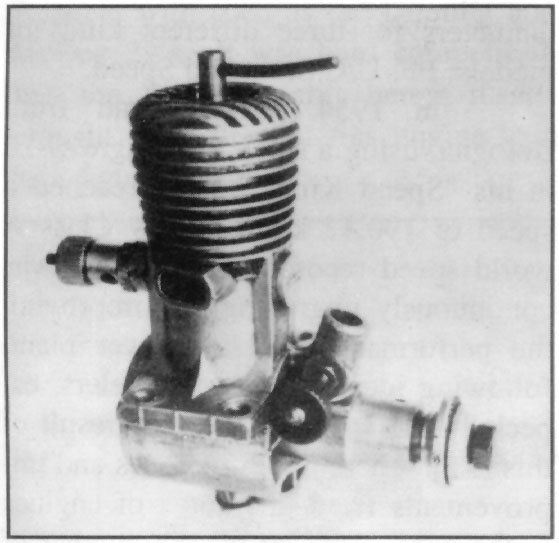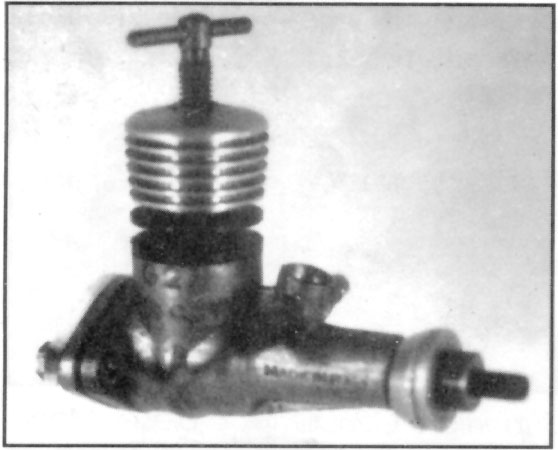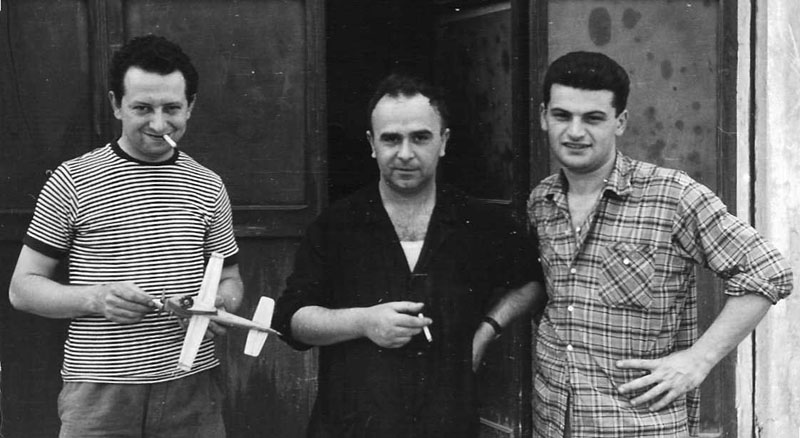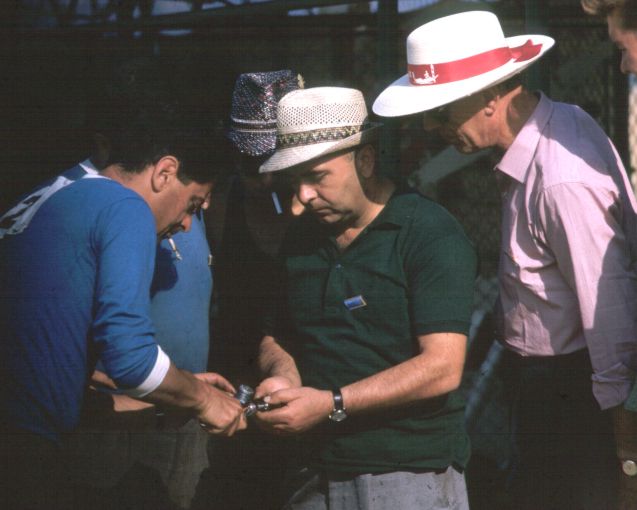1920—March 26, 2009
Italian Designer and Maker of the OSAM and SuperTigre Engines
Little is known about Mr. Jaures Garofali, developer of the SuperTigre engine line. The following article by Salvi Angeloni of Lodi, Italy appeared in the February 1996 issue of The Engine Collectors’ Journal (Issue #121). The article is reprinted here with permission from the publication.
The O.S.A.M. Society team in 1937. From left to right are Jaures Garofali, Mr. Bertuzzi, and Mr. Ciampolini. The model they are holding appears to be powered by a Brown Jr.
An Introduction to SuperTigre
Background on a Modeling Pioneer
By Salvi Angeloni
Mr. Jaures Garofali, designer and manufacturer of the renowned SuperTigre engines, was born in Bologna, Italy in 1920. In 1937-38, he joined Valerio Ciampolini and a Mr. Bertuzzi, and the trio founded the company O.S.A.M. (Officina Sperimentale Apparecchi Motori, or Aircraft and Engines Experimental Workshop).
Mr. Ciampolini was probably the only model builder of the trio, and was a gas model winner at the “Italian Nationals” of 1937 and 1938. Most likely, the first machines in the OSAM workshop—a lathe and drill press—were bought with the prize money he received as the winner of an important contest during 1934, the “Coppa Bonmartini.”
The very first Garofali designed engine was the OSAM “G-1,” a 3.5 cc ignition engine. Only four or five of these little engines were built. Mr. Garofali used a progressive numbering system to designate the order for his early engines. He was stationed at an Italian Air Force base during WWII, from 1940 to 1941, where he worked with Valerio Ciampolini, who was the director of the Aerodynamic Research Vertical Wind Tunnel.
It was here, supposedly in his spare time, that Garofali built the G-9, an ignition engine of 6.83 cc displacement. Only three or four engines were alleged to have been made. Previous engine projects, the G-2, G-3, G-4, G-5, G-6, G-7 and G-8 remained, with few exceptions, as brain exercises or sketches on paper. A couple were built to experiment with a certain feature.
This numbering system was totally independent from the displacement of the engines. This lasted for some 23 years, until the G-33 of 1964, when Garofali changed the system by giving each engine a number equal to the displacement in hundredths of a cubic inch—probably to obtain better sales in foreign markets using the displacement standard.
One of the original OSAM G-9’s was owned by the well-known Italian modeler, G. Ridenti. Unfortunately, this engine was given to a friend who was killed driving a race car in 1960, at the Modena Race Course.
In 1942, Mr. Garofali was transferred to the Aeronautical Academy in Forli, where, working with warrant officer A. Paglliani and Mr. Zambianchi, he went on to produce several more G-9’s—around eight in total.
The G-10, G-11 and G-12 remained as paper concepts until 1943, when Mr. Garofali had the opportunity to see a 2 cc Swiss Dyno diesel. He immediately began designing his first diesel, the G-13. Returning to Bologna in September of 1943, he did not have the chance to produce any more engines until the end of 1945.
Mr. Garofali was working for a company that produced Espresso coffee machines. During his free time, he began working on the OSAM G-13, a 5.28 cc diesel. Twenty-four G-13 engines were built.
The year 1946 saw the production of the OSAM G-14, a 5.65 cc diesel. It featured a unique mounting. The crank case was equipped with two bolts on a vertical axis on each side. (See a scan of the old advertisement below.) These bolts allowed easier changing of down and side thrust settings, thus making trimming of a free-flight powered model much easier. Around 300 OSAM G-14’s were produced and marketed by the Aviomodelli Company, owned by Mr. A. Castellani. This company was still producing kits and accessories for the model builder at the time of this writing (1996).
Toward the end of 1946, while production of the G-14 was still going, Mr. Garofali joined forces with Mr. Leonardo Boreani. From this time on, the new engines produced would show the GB logo (Garofali-Boreani) preceding the sequential model number.
The first engine from the new company was the OSAM GB-15, a 6.28 cc diesel. This front intake design was equipped with a discharge valve in the rear, to serve as a shutoff to stop the engine at the end of the motor run. This engine found a very warm welcome by the Italian modelers because it was powerful and reliable. However, it had one drawback; a rather delicate crankshaft.
Early in 1947, OSAM produced an engine at the request of Aviomodelli, which the store sold under the name of “Uragano.” This engine had the same displacement as the GB-14, 6.28 cc, and was similar in overall appearance; however, there were numerous detail differences in the castings to tell them apart.
The year 1947 also saw production of the most famous and popular engine under the OSAM name, the OSAM GB-16. This was a very powerful 5.95 cc diesel which introduced the first rear rotary valve from this manufacturer. This engine was especially well received by the Italian modelers, who found engines from the U.S. much too expensive in these early post war years.
The diesel was still the simplest answer for powering models because it dispensed with the intricacies of the ignition engine, and allowed them to reach a lower figure on the weight scale. Later, the birth of the glow plug engine would change this feeling.
The OSAM GB-16, of which around 1000 were made, existed in three different Marks: MkI having a black crankcase, very small exhaust stacks, rear induction system screwed on the crankcase, cylinder held in position by a screwed on head, and a cut-off valve on the rear crankcase. Only around 50 of this version were built. The MkII was very similar to the MkI, except for a natural finish on the case and somewhat larger exhaust stacks. The MkIII, produced during 1948, is the result of improvements to the previous models. The MkIII had still larger exhaust stacks, longer mounting beams, and a more practical rear rotor valve assembly, now attached to the case by three screws.
A cut-off was not supplied with the last of these engines, probably due to the heavy use of the engine in control line stunt and speed models.
At the 1948 Italian Nationals, G. Ridenti, still active and a pioneer of Italian modeling, reached the remarkable speed of 178 km/h (110.6 mph) using 60-foot lines. This probably remains one of the highest speeds obtained by a model using a diesel engine. This same year saw the birth of the little OSAM BG-18, a diesel of 2.82 cc. It was introduced on the market before the OSAM GB-17, of which the GB-18 was a scaled down version. The GB-17 was a very powerful 9.8 cc rear rotary valve diesel, noted for its ball bearing supported crankshaft, and very light (for a diesel) aluminum 2-ring piston.
During 1949, Mr. Garofali parted company with Mr. Boreani, who retained the OSAM name. The company had a short life, and produced only a pair of different engines: the OSAM 1700 “Lilliput,” a glow engine of 1.7 cc, and the OSAM 2500, a 2.5 cc glow and diesel.
The End of OSAM and the Beginning of SuperTigre
The first engine produced under the SuperTigre name was the G-19, an excellent 4.82 cc diesel, soon to be followed by an even more powerful glow version. In 1950, Mr. Garofali designed and produced the engine that was to become one of the most famous, and most used, SuperTigre engines. This engine was flown by modelers in every country, and produced more than its share of first places for a net fifteen years. It was the 2.5 cc Supertigre G-20 Glow.
The very first versions of this engine had a sandcast crankcase with a square exhaust stack, single ball bearing on the shaft, finless head, and two ring piston. The G-20 was pressure die cast, with dual ball bearings on the shaft, modified fuel transfer, and was supplied with three different colors of plastic venturi inserts—offering different choke diameters for three different kinds of models: FF, U/C Stunt, and Speed.
In 1954, Amato Prati from Bologna, using a stock SuperTigre G-20 in his “Speed King” model, reached a speed of 190.47 km/h—a new Class A world speed record. Mr. Garofali was continuously upgrading and improving the performance of his powerplant, following ideas from the modelers, especially the speed fliers. The result was that there were differences and improvements from one batch of engines to the next. This brings the variation of marks to a very high number, and Mr. Garofali made no attempt to keep track of the changes.
Two years later, on May 20, 1956, with the then current Supertigre G-20 Lappato (lapped piston, strengthened crankcase with removable rear cover, and many internal changes), A. Marconi, another well-known speed flier, reached with his model “Tajavento” (Wind Cutter) the remarkable speed of 215.56 km/h—another Class A world speed record. It would be possible to write a book on the G-20 alone, with its many achievements and different models—provided the author had enough patience and time to find at least one engine of each mark.
A logical development of the same engine concept resulted in the SuperTigre G-21, a 5 cc glow engine. It was supposed to match the successes of the G-20 in Class B. The engine obtained outstanding results, but it had to compete with engines such as the Dooling and McCoy 29’s. It was hard competition, and the fight for still better results brought the marks of this engine to a high figure as well.
Then followed the SuperTigre G-22 “Baby Tigre,” a 1.3 cc glow, and the G-23, a 2.47 cc diesel—both aimed at the Sunday flier. Next came the G-24, a 10 cc racing engine having rear rotary valve and ringed piston, available as either glow or ignition. This engine was aimed at the race car clan and speed flier. Mr. Garofali still wanted to compete with the established makes like Dooling and McCoy. The engine still had its loyal followers in Italy, but it could not reach the fame and success of its smaller brother, the G-20.
The G series engines which followed were, all but one, aimed at the sport modeler. They were also for the builder who wanted an easy to operate, reliable, and reasonably powerful engine to power models flown mainly for leisure. The only engine from this series intended to be used also for competition was the SuperTigre G-30, a 2.5 cc diesel that found favor in the nose of many FAI Team Race models in the late 1950’s.
—Salvi Angeloni
Remebering a Visit to the SuperTigre Factory
By Dave Harding
“I just updated our page on engines, and in the process of posting a picture I took at the ‘SuperTigre Factory’ in 1957, I came across your site. I have attached the photo with Prati and Garofali, which you are welcome to use. See our website for more.
My family took a vacation to Catollica, on the Adriatic Coast, and I rented a Vespa and rode, with my 14 year old brother on the back, up the Via Emilia to Bologna. Sr. Garofali made us very welcome, and put together a G15 diesel especially for me. Sr. Prati just happened to be there at the time, and it was a joy to share stories of the current speed progress as I was a friend of Pete Wright, the Brit who had previously held the Class A record, using an ED Record motor.
The SuperTigre ‘factory’ was a few rooms in what looked like a row home, just off the main road. I didn’t see many people there, so it must have been a very small operation. Some Croydon and District model club friends and I visited again the following year, and bought some more engines, too. Nothing much had changed.”
—Dave Harding
A Summary of Engines, Models, and Years
The introduction of radio control almost completely changed the way of thinking and designing engines. No longer was the emphasis solely on ear-splitting power, but rather on good power matched with ease of operation, and very consistent performance. As mentioned before, there was never a Supertigre G-34. The engines which followed the G-33 got their identification from the cubic inch displacement of each one. These included: ST .15, .21, .35, .40, .46, .51, .56, and .60, with variations such as G20-19, G-20-23, G21-45 and so on.
In his later years, Mr. Garofali was mainly designing engines for R/C and U/C. Still, even at the age of 75, he was the energetic hearth of his company. Despite Mr. Garofali’s passing in 2009, his products have opened the door for many people to enjoy the pleasures of flying model airplanes.
Click here for a summary Mr. Garofali’s SuperTigre engines.
The engines shown on this page are just a few of the many variations that OSAM and SuperTigre manufactured over the years. Issue #121 of The Engine Collector’s Journal shows and describes the progression of these engines, as many have been cataloged by collectors.
If you are interested in learning more about Mr. Garofali, the Academy of Model Aeronautics has published a short biography. Additionally, SuperTigre engines are still distributed in the US by Great Planes. Visit their website for more.

